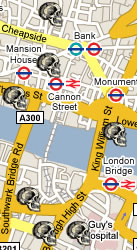 The Museum of London and The Times have collaborated to bring us a most delicious weekend-waster: an interactive map of London with skulls pinpointing the exact location of tens of thousands of buried skeletons found during construction and often reinterred.
The Museum of London and The Times have collaborated to bring us a most delicious weekend-waster: an interactive map of London with skulls pinpointing the exact location of tens of thousands of buried skeletons found during construction and often reinterred.
Zoom in to see who was caught dead underneath a specific street, or just browse around the town, clicking on the skulls to read about the remains found on that spot. There are some great ones.
Another skeleton was found with a metal spike lodged in its spine. Its owner, a man who was buried in Smithfield, East London, in about 1350, was probably hit with an arrow or spear, but the attack did not kill him. He survived only to catch bubonic plague in his late thirties or early forties. “Somehow the injury didn’t cause an infection,” Mr White said. “The body has reacted by building bone around the projectile. He survived for months or possibly years. He was found in a large plot of land set aside for burying victims of the Black Death.” It is not known why the man was attacked, but it is thought that he may have been a soldier in the Hundred Years War.
Such a burn, surviving a spear in the spine in the Hundred Years War only to die of plague along with a good third of the rest of Europe.
The syphilitic, insane prostitute with rotten teeth and rickets from having been kept out of sunlight in childhood is a tragic figure of Hugoean proportion as well. I can’t help but wonder how much business she did, what with the deformed bones, decaying mouth and suppurating syphilis sores.